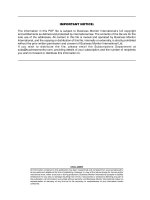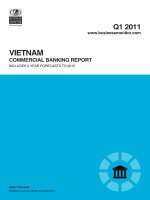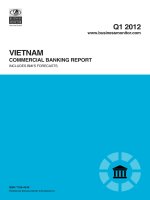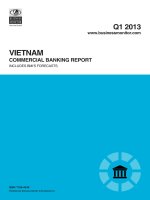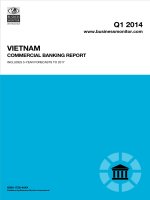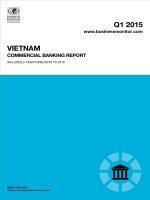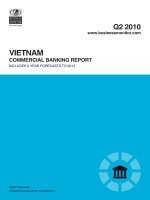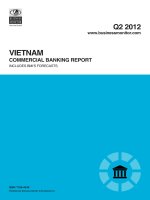Vietnam commercial banking report q2 2012
Bạn đang xem bản rút gọn của tài liệu. Xem và tải ngay bản đầy đủ của tài liệu tại đây (599.95 KB, 62 trang )
Q2 2012
www.businessmonitor.com
COMMERCIAL BANKING REPORT
ISSN 1758-454X
Published by Business Monitor International Ltd.
VIETNAM
INCLUDES BMI'S FORECASTS
Business Monitor International
85 Queen Victoria Street
London
EC4V 4AB
UK
Tel: +44 (0) 20 7248 0468
Fax: +44 (0) 20 7248 0467
Email:
Web:
© 2012 Business Monitor International.
All rights reserved.
All information contained in this publication is
copyrighted in the name of Business Monitor
International, and as such no part of this publication
may be reproduced, repackaged, redistributed, resold in
whole or in any part, or used in any form or by any
means graphic, electronic or mechanical, including
photocopying, recording, taping, or by information
storage or retrieval, or by any other means, without the
express written consent of the publisher.
DISCLAIMER
All information contained in this publication has been researched and compiled from sources believed to be accurate and reliable at the time of
publishing. However, in view of the natural scope for human and/or mechanical error, either at source or during production, Business Monitor
International accepts no liability whatsoever for any loss or damage resulting from errors, inaccuracies or omissions affecting any part of the
publication. All information is provided without warranty, and Business Monitor International makes no representation of warranty of any kind as
to the accuracy or completeness of any information hereto contained.
VIETNAM COMMERCIAL
BANKING REPORT Q2 2012
INCLUDES 5-YEAR INDUSTRY FORECASTS TO 2016
Part of BMI’s Industry Report & Forecasts Series
Published by: Business Monitor International
Copy deadline: March 2012
Vietnam Commercial Banking Report Q2 2012
© Business Monitor International Ltd Page 2
Vietnam Commercial Banking Report Q2 2012
© Business Monitor International Ltd Page 3
CONTENTS
Executive Summary 5
Table: Levels (VNDbn) 5
Table: Levels (US$bn) 5
Table: Levels At March 2011 5
Table: Annual Growth Rate Projections 2012-2016 (%) 6
Table: Ranking Out Of 59 Countries Reviewed In 2011 6
Table: Projected Levels (VNDbn) 6
Table: Projected Levels (US$bn) 7
SWOT Analysis 8
Vietnam Commercial Banking SWOT 8
Vietnam Political SWOT 9
Vietnam Economic SWOT 10
Vietnam Business Environment SWOT 11
Business Environment Outlook 12
Commercial Banking Business Environment Ratings 12
Table: Commercial Banking Business Environment Ratings 12
Commercial Banking Business Environment Rating Methodology 12
Table: Asia Commercial Banking Business Environment Ratings 14
Global Commercial Banking Outlook 15
Asia Banking Sector Outlook 20
Three Threats To Asia's Banks In 2012 20
Asia Banking Sector Forecast Overview 25
Table: Banks' Bond Portfolios 25
Table: Asia Commercial Banking Business Environment Ratings 26
Table: Comparison of Loan/Deposit & Loan/Asset & Loan/GDP ratios 27
Table: Anticipated Developments in 2012 28
Table: Comparison of Total Assets & Client Loans & Client Deposits (US$bn) 29
Table: Comparison of US$ Per Capita Deposits (2011) 30
Table: Interbank Rates and Bond Yields 31
Vietnam Banking Sector Outlook 32
Banking Sector Reforms Positive For The Economy 32
Economic Outlook 35
Table: Vietnam – Economic Activity 37
Company Profiles 38
Bank for Foreign Trade of Vietnam (Vietcombank) 38
Table: Vietnam Stock Market Indicators 39
Table: Vietnam Balance Sheet (US$mn) 39
Table: Vietnam Key Ratios (%) 39
VietinBank 40
Table: Key Statistics For VietinBank, 2005-2008 (VNDmn) 41
Vietnam Commercial Banking Report Q2 2012
© Business Monitor International Ltd Page 4
Agribank 42
Table: Vietnam Balance Sheet (LCYmn) 43
Table: Vietnam Balance Sheet (US$mn) 43
Table: Vietnam Key Ratios (%) 43
Asia Commercial Bank 44
Table: Vietnam Stock Market Indicators 45
Table: Vietnam Balance Sheet (LCYmn) 45
Table: Vietnam Balance Sheet (US$mn) 46
Table: Vietnam Key Ratios (%) 46
Eximbank 47
Table: Balance Sheet (VNDmn, unless stated) 48
Table: Balance Sheet (US$mn, unless stated) 48
Table: Key Ratios (%) 48
Vietnam Technological and Commercial Joint-stock Bank (Techcombank) 49
Table: Vietnam Balance Sheet (LCYmn) 50
Table: Vietnam Balance Sheet (US$mn) 50
Table: Vietnam Key Ratios (%) 50
Viet A Joint Stock Commercial Bank (Vietabank) 51
Table: Vietnam Stock Market Indicators 51
Table: Vietnam Balance Sheet (LCYmn) 52
Table: Vietnam Balance Sheet (US$mn) 52
Table: Vietnam Key Ratios (%) 52
Housing Development Commercial Joint Stock Bank (HDBank) 53
Sacombank 54
Table: Stock Market Indicators 55
Table: Balance Sheet (VNDmn, unless stated) 55
Table: Balance Sheet (US$mn, unless stated) 56
Table: Key Ratios (%) 56
BMI Banking Sector Methodology 57
Table: Commercial Banking Business Environment Indicators And Rationale 59
Table: Weighting Of Indicators 60
Vietnam Commercial Banking Report Q2 2012
© Business Monitor International Ltd Page 5
Executive Summary
Table: Levels (VNDbn)
Date
Total
assets
Client
loans
Bond
portfolio
Other
Liabilities
and capital
Capital
Client
deposits
Other
March 2010 2,342,752.9 1,935,790.0 159,117.9 247,845.0 2,342,752.9 336,053.0 1,771,242.5 235,457.4
March 2011 3,092,978.4 2,584,860.0 225,505.0 282,613.4 3,092,978.4 479,064.0 2,220,589.1 393,325.3
Change, % 32% 34% 42% 14% 32% 43% 25% 67%
Source: BMI; Central banks; Regulators
Table: Levels (US$bn)
Date
Total
assets
Client
loans
Bond
portfolio
Other
Liabilities
and
capital
Capital
Client
deposits
Other
March 2010 122.8
101.4
8.3
13.0
122.8
17.6
92.8
12.3
March 2011 148.0
123.7
10.7923
13.5
148.0
22.9
106.3
18.8
Change, % 21%
22%
29%
4%
21%
30%
15%
53%
Source: BMI; Central banks; Regulators
Table: Levels At March 2011
Loan/deposit ratio Loan/asset ratio
Loan/GDP ratio
GDP Per Capita,
US$
Deposits per
capita, US$
116.40% 83.57%
122.63%
1,068
1,206
Rising Rising
Falling
Source: BMI; Central banks; Regulators
Vietnam Commercial Banking Report Q2 2012
© Business Monitor International Ltd Page 6
Table: Annual Growth Rate Projections 2012-2016 (%)
Assets
Loans
Deposits
Annual Growth Rate 20
20
14
CAGR 21
21
14
Ranking 3
3
15
Source: BMI; Central banks; Regulators
Table: Ranking Out Of 59 Countries Reviewed In 2011
Loan/deposit ratio Loan/asset ratio
Loan/GDP ratio
6 1
11
Local currency asset
growth Local currency loan growth
Local currency deposit growth
3 2
9
Source: BMI; Central banks; Regulators
Table: Projected Levels (VNDbn)
2008
2009
2010
2011e
2012f
2013f
2014f
2015f
2016f
Total assets 1,747,335 2,286,321 2,953,154 3,720,973 4,614,007 5,536,808 6,644,170 7,973,004 9,567,605
Client loans 1,339,260 1,869,260 2,475,540 3,119,180 3,867,784 4,641,341 5,569,609 6,683,530 8,020,236
Client
deposits 1,341,143 1,680,717 2,209,896 2,651,876 3,076,176 3,506,840 3,997,798 4,557,489 5,195,538
e/f = estimate/forecast. Source: BMI; Central banks; Regulators
Vietnam Commercial Banking Report Q2 2012
© Business Monitor International Ltd Page 7
Table: Projected Levels (US$bn)
2008
2009
2010
2011e
2012f
2013f
2014f
2015f
2016f
Total assets 99.94
123.73
151.46
176.89
229.55
283.94
349.69
421.85
508.92
Client loans 76.60
101.16
126.96
148.29
192.43
238.02
293.14
353.63
426.61
Client deposits 76.71
90.95
113.34
126.07
153.04
179.84
210.41
241.14
276.36
e/f = estimate/forecast. Source: BMI; Central banks; Regulators
Vietnam Commercial Banking Report Q2 2012
© Business Monitor International Ltd Page 8
SWOT Analysis
Vietnam Commercial Banking SWOT
Strengths
Rapid growth in the sector has been seen in recent years, and this is unlikely to slow
significantly over our forecast period.
Untapped potential means there is room to grow; the market is nowhere near
saturation.
High savings rate among Vietnam residents.
Weaknesses
Domestic banks lack both the capital and technology to sustain high credit growth.
The financial accounts of many banks are still opaque.
Opportunities
The Vietnamese population is underbanked, offering an opening to commercial banks.
Income levels are likely to rise strongly over the medium term.
Threats
Macroeconomic instabilities threatens the credibility of the government and could
potentially bring economic policy away from further liberalisation.
Vietnam Commercial Banking Report Q2 2012
© Business Monitor International Ltd Page 9
Vietnam
Political
SWOT
Strengths
The Communist Party of Vietnam remains committed to market-oriented reforms and
we do not expect major shifts in policy direction over the next five years. The one-party
system is generally conducive to short-term political stability.
Relations with the US have witnessed a marked improvement, and Washington sees
Hanoi as a potential geopolitical ally in South East Asia.
Weaknesses
Corruption among government officials poses a major threat to the legitimacy of the
ruling Communist Party.
There is increasing (albeit still limited) public dissatisfaction with the leadership's tight
control over political dissent.
Opportunities
The government recognises the threat corruption poses to its legitimacy, and has
acted to clamp down on graft among party officials.
Vietnam has allowed legislators to become more vocal in criticising government
policies. This is opening up opportunities for more checks and balances within the one-
party system.
Threats
Macroeconomic instabilities in 2012 are likely to weigh on public acceptance of the
one-party system, and street demonstrations to protest economic conditions could
develop into a full-on challenge of undemocractic rule.
Although strong domestic control will ensure little change to Vietnam's political scene
in the next few years, over the longer term, the one-party-state will probably be
unsustainable.
Relations with China have deteriorated over recent years due to Beijing's more
assertive stance over disputed islands in the South China Sea and domestic criticism
of a large Chinese investment into a bauxite mining project in the central highlands,
which could potentially cause wide-scale environmental damage.
Vietnam Commercial Banking Report Q2 2012
© Business Monitor International Ltd Page 10
Vietnam
Economic
SWOT
Strengths
Vietnam has been one of the fastest-growing economies in Asia in recent years, with
GDP growth averaging 7.1% annually between 2000 and 2011.
The economic boom has lifted many Vietnamese out of poverty, with the official
poverty rate in the country falling from 58% in 1993 to 9.5% in 2010.
Weaknesses
Vietnam still suffers from substantial trade, current account and fiscal deficits, leaving
the economy vulnerable to global economic uncertainties in 2012. The fiscal deficit is
dominated by substantial spending on social subsidies that could be difficult to
withdraw.
The heavily-managed and weak currency reduces incentives to improve quality of
exports, and also keeps import costs high, contributing to inflationary pressures.
Opportunities
WTO membership has given Vietnam access to both foreign markets and capital,
while making Vietnamese enterprises stronger through increased competition.
The government will in spite of the current macroeconomic woes, continue to move
forward with market reforms, including privatisation of state-owned enterprises, and
liberalising the banking sector.
Urbanisation will continue to be a long-term growth driver. The UN forecasts the urban
population rising from 29% of the population to more than 50% by the early 2040s.
Threats
Inflation and deficit concerns have caused some investors to re-assess their hitherto
upbeat view of Vietnam. If the government focuses too much on stimulating growth
and fails to root out inflationary pressure, it risks prolonging macroeconomic instability,
which could lead to a potential crisis.
Prolonged macroeconomic instability could prompt the authorities to put reforms on
hold as they struggle to stabilise the economy.
Vietnam Commercial Banking Report Q2 2012
© Business Monitor International Ltd Page 11
Vietnam
Business Environment SWOT
Strengths
Vietnam has a large, skilled and low-cost workforce which has made the country
attractive to foreign investors.
Vietnam's location – its proximity to China and South East Asia, and its good sea links
– makes it a good base for foreign companies to export to the rest of Asia, and
beyond.
Weaknesses
Vietnam's infrastructure is still weak. Roads, railways and ports are inadequate to cope
with the country's economic growth and links with the outside world.
Vietnam remains one of the world's most corrupt countries. According to Transparency
International's 2011 Corruption Perceptions Index, Vietnam ranks 112 out of 183
countries.
Opportunities
Vietnam is increasingly attracting investment from key Asian economies, such as
Japan, South Korea and Taiwan. This offers the possibility of the transfer of high-tech
skills and know-how.
Vietnam is pressing ahead with the privatisation of state-owned enterprises and the
liberalisation of the banking sector. This should offer foreign investors new entry
points.
Threats
Ongoing trade disputes with the US, and the general threat of American protectionism,
which will remain a concern.
Labour unrest remains a lingering threat. A failure by the authorities to boost skills
levels could leave Vietnam a second-rate economy for an indefinite period.
Vietnam Commercial Banking Report Q2 2012
© Business Monitor International Ltd Page 12
Business Environment Outlook
Commercial Banking Business Environment Ratings
Table: Commercial Banking Business Environment Ratings
Limits of potential returns Data
Score out of 10
Ratings score; out of 100
Total assets; end 2012, US$bn 176.9
6
Market Structure 70
Growth in total assets; 2012-2016, US$bn 279.4
7
Growth in client loans; 2012-2016, US$bn 234.2
8
Per-capita GDP; 2012, US$ 1,597.9
3
Country Structure 55
Tax 2.9
3
GDP volatility 0.7
10
Financial infrastructure 5.6
6
Risks to realisation of returns
Regulatory framework and development 2.0
2
Market Risk 37
Regulatory framework and competitive landscape 5.0
5
Moody's rating for local currency deposits 3.5
4
Long-term financial risk 4.6
5
Country Risk 48
Long-term external risk 3.7
4
Long-term policy continuity 7.0
7
Legal framework 3.7
4
Bureaucracy 3.9
4
Commercial banking business environment rating
58
Source: BMI
Commercial Banking Business Environment Rating Methodology
Since Q108, we have described numerically the banking business environment for each of the countries
surveyed by BMI. We do this through our Commercial Banking Business Environment Rating (CBBER),
a measure that ensures we capture the latest quantitative information available. It also ensures consistency
across all countries and between the inputs to the CBBER and the Insurance Business Environment
Rating, which is likewise now a feature of our insurance reports. Like the Business Environment Ratings
calculated by BMI for all the other industries on which it reports, the CBBER takes into account the
Vietnam Commercial Banking Report Q2 2012
© Business Monitor International Ltd Page 13
limits of potential returns and the risks to the realisation of those returns. It is weighted 70% to the former
and 30% to the latter.
The evaluation of the 'Limits of potential returns' includes market elements that are specific to the
banking industry of the country in question and elements that relate to that country in general. Within the
70% of the CBBER that takes into account the 'Limits of potential returns', the market elements have a
60% weighting and the country elements have a 40% weighting. The evaluation of the 'Risks to
realisation of returns' also includes banking elements and country elements (specifically, BMI's
assessment of long-term country risk). However, within the 30% of the CBBER that take into account the
risks, these elements are weighted 40% and 60%, respectively.
Further details on how we calculate the CBBER are provided at the end of this report. In general, though,
three aspects need to be borne in mind in interpreting the CBBERs. The first is that the market elements
of the 'Limits of potential returns' are by far the most heavily weighted of the four elements. They account
for 60% of 70% (or 42%) of the overall CBBER. Second, if the market elements are significantly higher
than the country elements of the 'Limits of potential returns', it usually implies that the banking sector is
(very) large and/or developed relative to the general wealth, stability and financial infrastructure in the
country. Conversely, if the market elements are significantly lower than the country elements, it usually
means that the banking sector is small and/or underdeveloped relative to the general wealth, stability and
financial infrastructure in the country. Third, within the 'Risks to the realisation of returns' category, the
market elements (ie how regulations affect the development of the sector, how regulations affect
competition within it, and Moody's Investor Services' ratings for local currency deposits) can be
markedly different from BMI's long-term risk rating.
Vietnam Commercial Banking Report Q2 2012
© Business Monitor International Ltd Page 14
Table: Asia Commercial Banking Business Environment Ratings
Limits of Potential Returns Risks to Potential Returns Overall
Market Structure
Country
Structure
Market Risks
Country Risks
Rating
Ranking
Bangladesh 46.7
45.0
43.3
44.0
45.3
54
China 93.3
55.0
63.3
74.0
75.5
13
Hong Kong 76.7
92.5
73.3
84.0
82.0
6
India 83.3
57.5
60.0
56.0
68.4
28
Indonesia 76.7
65.0
80.0
52.0
69.4
24
Japan 33.3
77.5
66.7
80.0
58.1
37
Malaysia 73.3
80.0
83.3
80.0
77.6
11
Pakistan 40.0
50.0
53.3
42.0
44.8
55
Philippines 50.0
62.5
60.0
52.0
55.1
46
Singapore 66.7
95.0
96.7
86.0
81.7
7
Sri Lanka 23.3
55.0
33.3
46.0
37.5
57
South Korea 80.0
82.5
83.3
78.0
80.7
9
Taiwan 76.7
72.5
86.7
76.0
76.6
12
Thailand 63.3
65.0
86.7
74.0
68.5
27
Vietnam 70.0
55.0
36.7
48.0
57.8
38
United States 90.0
85.0
100.0
80.0
88.0
2
Scores out of 100, with 100 the highest. Source: BMI
Vietnam Commercial Banking Report Q2 2012
© Business Monitor International Ltd Page 15
Global Commercial Banking Outlook
Europe Is Still The Main Event
With BMI's core macroeconomic forecasts pointing toward a sustained if weak economic recovery, the
eurozone crisis remains the biggest risk to the global banking sector. Looking at the outlook region-by-
region, there are none that would be unaffected by a major deterioration in the European crisis. We
covered this closely in the Q1 2012 report ('Europe On The Brink'), but some questions have been
addressed since that time, namely whether the European Central Bank (ECB) would intervene to stave off
a short-term credit crunch and expand support to peripheral bond markets (it has, in increasingly bold
fashion). We retain our core view that the eurozone is set to 'muddle through' the current crisis, with the
monetary bloc surviving, albeit only after significant zone-wide macroeconomic and fiscal reforms.
However, a renewed escalation to the crisis would pose significant risks to our regional banking outlooks.
Developed State And Emerging Market Commercial Banking Overview
US: While the US banking sector recovery remains tentative, there are several reasons why we believe
the US banking sector has turned the corner, and we continue to project fairly robust lending and asset
growth in 2012. Among other positive factors: lending growth is picking up, loan standards continue to
ease, and banks are looking increasingly to profit-making opportunities, rather than merely ensuring their
survival. However, the European crisis poses a major threat to the US banking sector; the long end of the
yield curve is set to remain low-yielding for years, which will hurt profitability, and the regulatory regime
is increasingly restrictive.
Signs Of Life, But Real Estate Lending Still Trailing
US – Loans By Category, % chg y-o-y
Source: BMI, Federal Reserve
Vietnam Commercial Banking Report Q2 2012
© Business Monitor International Ltd Page 16
Eurozone: From an aggregate level the eurozone banking sector would seem to be recovering well from
the turmoil of 2008 and 2009. However, this masks increasing disparity between the relatively prosperous
core and crumbling periphery, as well as stresses in traditional bank funding markets across the region.
We cannot discount the possibility of a major credit crunch should the debt crisis reach its meltdown
moment. While we expect continued industry growth in aggregate, this masks deep divisions at the
national level. Going forward, growing stresses in the banking system will require the ECB to intervene
still further. This will likely take the form of additional cuts to the refinancing rate, an expansion of the
Securities Market Programme (which has already purchased EUR213bn in government debt) and a
reduction in collateral requirements for securities repoed at the ECB. We still expect the central bank to
have to significantly ramp up its intervention in the sovereign debt markets from 2012 given the
enormous refinancing demands of the region's issuers.
Emerging Asia: In 2012 we expect weaker earnings, hampered by foreign funding constraints, slower
credit growth, and higher non-performing loans. One corollary of the surge in credit growth seen in 2010
and 2011, and the inevitable slowdown in 2012, will be a resurgence in non-performing loans (NPLs).
Our core view is for a sharp slowdown in real GDP growth across the board this year, lead by a hard
landing in China and a slowdown in trade growth driven by a recession in the eurozone. These factors
alone are likely to lead to an uptick in NPLs. However, when we combine this with the impact of
weakening housing markets across the region and tighter availability of credit, the impact on NPL is
likely to be exacerbated. We look for the likes of China, Hong Kong, and Australia to see a surge in bad
debts in 2012.
Leveraged On FX Loans
Asia – Foreign Exchange Loans Of Asian Banks
Source: BMI
Vietnam Commercial Banking Report Q2 2012
© Business Monitor International Ltd Page 17
Emerging Europe: We maintain our wary view towards Central and Eastern European (CEE) banking
sectors on the back of continued macroeconomic and financial headwinds emanating from the eurozone
sovereign debt crisis. We also hold to our preference for the Czech Republic and Poland's banking sectors
on the grounds of stability and growth potential, respectively, while reaffirming our negative outlook for
the Hungarian and Ukrainian banking. We also caution that Southeastern European banking sectors are
showing some worrying risk indicators.
CE Generally Better Pl
aced Despite High Foreign Claims On Assets
CEE – European Banks' Claims, % of Total Assets
Source: BIS, BMI
Latin America: We believe asset and loan growth will remain strong in 2012, driven by stable
fundamentals and the use of monetary stimulus in those markets where credit cycles are slowing. In
addition, we do not view the prevalence of European banks operating in the Latin American region as a
risk to regional banking sector stability. Indeed, those sectors which have greater foreign participation
tend to be the most attractive from a growth perspective, with any serious threats to sector stability
coming mainly from domestic factors.
Sub-Saharan Africa: The outlook for the South African, Nigerian, Kenyan and Ghanaian banking
sectors is mixed. We see Nigeria and Ghana as having the strongest growth potential over the coming
year, while South Africa should see slow but stable expansion, and Kenya will likely struggle amid
various macroeconomic challenges.
Vietnam Commercial Banking Report Q2 2012
© Business Monitor International Ltd Page 18
Diverse Regional Picture
Africa – Total Banking Sector Loans, % chg y-o-y
Source: Central Banks; BMI
Middle East And North Africa: The outlook for banks across the Middle East and North Africa
(MENA) continues to diverge, with oil-fuelled spending in the Gulf facilitating a slight improvement in
lending conditions, whilst risks of currency devaluations and a spike in non-performing loans tempers our
outlook on financial institutions in Egypt and the Levant. Although the region is by no means
homogenous, the recent spike in interbank lending rates from Saudi Arabia to Jordan would suggest that
risks of a broad-based tightening in credit conditions cannot be ruled out, particularly given rising
regional tensions and ongoing concerns surrounding the fate of the eurozone.
Vietnam Commercial Banking Report Q2 2012
© Business Monitor International Ltd Page 19
Credit Conditions Improving For Some
MENA – Banking Sector Credit, % chg y-o-y
Source: BMI/Respective Central Banks
Vietnam Commercial Banking Report Q2 2012
© Business Monitor International Ltd Page 20
Asia Banking Sector Outlook
Three Threats To Asia's Banks In 2012
BMI View: In 2011 Asian banking stocks weakened substantially as earnings multiples collapsed amid
record earnings. In 2012, we expect the reverse, as weaker earnings, hampered by foreign funding
constraints, slower credit growth, and higher non-performing loans (NPLs), to be offset by multiple
expansion. On balance, we retain our bearish bias, although we highlight key technical areas to watch.
Asian banking equities suffered a difficult year in 2011. The Bloomberg Asia Banking Index recorded a
13% fall, taking prices back to mid-2009 levels. While the index is heavily weighted towards Chinese
banks, equity losses were recorded across the board. As the accompanying chart shows, only Indonesian
financial equities gained in 2011, with the rest posting varying degrees of losses, led by India.
Only Indonesia In The Black
Asia – 2011 Returns For MSCI Financial Indices, %
Source: BMI
This weakness in equity prices came despite an impressive earnings display on the whole. The Bloomberg
Asian Banking Index saw its earnings increase by an impressive 27%, with the price fall coming entirely
via a collapse in multiples. In fact, the vast majority of countries saw banking sector earnings hit a new
high, accompanied by new highs in book values, taking P/E and P/B multiples to very low levels. This is
most starkly shown in the case of the MSCI India Financials index. While the market lost 29% thorough
2011, earnings were actually up 25%, with the loss coming from a staggering 10.7 percentage point
decline in the P/E ratio.
Vietnam Commercial Banking Report Q2 2012
© Business Monitor International Ltd Page 21
Earnings Up, Prices Down
India – MSCI India Financials Index, P/E Ratio & Earnings Per Share
Source: BMI
In 2012, we expect to see a reversal of trends seen in 2011. On the whole we should see earnings weaken,
quite substantially is some cases, and book values follow suit. Multiples should expand, however (greatly
in countries such as Hong Kong, Singapore, and Australia, which run serious risks of losses). The big
question is whether prices will manage to mount a sustainable increase in the face of weakening earnings
or continue their slide from the April 2011 peak, when we voiced our concerns surrounding Asian banks.
On the whole, we believe that another price low in on the cards this year in the Bloomberg Asia Banking
Index, although this is contingent upon a continued deterioration in the regional economy, led by China,
and further global economic dislocation, which would both hit earnings and raise equity risk premiums.
Vietnam Commercial Banking Report Q2 2012
© Business Monitor International Ltd Page 22
Foreign Funding Difficulties To Continue
We recently articulated the risks faced by Asian financial systems from the reduced availability of
overseas funding amid growing global risk aversion and deleveraging in the European banking system.
Asian banks have rapidly expanded their foreign currency-denominated loan books in recent years, with
the FX loans-to-deposit ratio now in excess of 100% as corporates and speculators have looked to take
advantage of low US dollar interest rates versus local currency rates. With US dollar funding conditions
tightening over recent months (despite easing somewhat following the ECB's measures to improve
funding conditions), this is likely to have negative implications for Asian banks. Firstly, it will reduce net
interest margins (NIM) on FX-denominated loans as funding costs increase. Secondly, the recent increase
in the value of the US dollar in Q411 will have raised the local currency value of borrowings, making it
more difficult to meet loan repayments. We could perhaps see the lagged impact of this show up in
greater non-performing foreign currency loans in the coming months. Our expectation of another bout of
US$ strength suggests this problem is also likely to reoccur later in the year.
Leveraged On FX Loans
Asia – Foreign Exchange Loans Of Asian Banks
Source: BMI
Shrinking Credit Growth
One major supportive factor for banking sector earnings in 2011 was the rise in the amount of credit
banks extended, with growth hitting new highs in the likes of Hong Kong and Singapore. In 2012 we see
credit growth falling across the board, with not a single country in the region expected to see an
acceleration in credit. This will act as a clear and direct drag on earnings growth. Net interest margins are
also unlikely to offer much help as, despite our expectations that short-term interest rates will fall, long-
Vietnam Commercial Banking Report Q2 2012
© Business Monitor International Ltd Page 23
term interest rates should also fall. With credit growth weakening and NIMs potentially falling, we
believe these dynamics are sure to hurt banks' bottom lines in 2012.
Malaysia Leading T
he Way
Asia – Foreign Exchange Loan Growth By Country, % chg y-o-y
Source: BMI
Rising NPLs
One corollary of the surge in credit growth seen in 2010 and 2011, and the inevitable slowdown in 2012,
will be a resurgence in NPLs. Our core view is for a sharp slowdown in real GDP growth across the board
this year, led by a hard landing in China and a slowdown in trade growth driven by a recession in the
eurozone. These factors alone are likely to lead to an uptick in NPLs. However, when we combine this
with the impact of weakening housing markets across the region and tighter availability of credit, the
impact on NPL is likely to be exacerbated. We look for the likes of China, Hong Kong, and Australia to
see a surge in bad debts in 2012.
Technical Levels To Watch
The technical chart of the Bloomberg Asia Banking Index shows tough resistance lies ahead in the near
term at the 150 level, and a break of this level could trigger a run at the 2011 high. However, should
prices approach this level, we would turn outright bearish given the prospect of weaker earnings in 2012.
In the event of weakness, we identify the 115 level. The gap left by the break-out in 2009 is a potential
downside target, and a region-wide recession could see prices return to this level. Given our bullish long-
term outlook on regional growth, however, we would see any move to this area as a long-term
opportunity.
Vietnam Commercial Banking Report Q2 2012
© Business Monitor International Ltd Page 24
Right On Resistance
Asia – Bloomberg Asia Banking Index
Source: BMI
